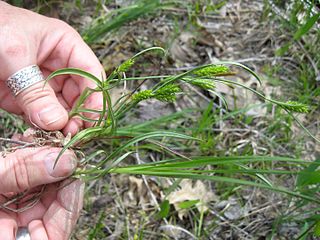
Carex athrostachya is a species of sedge known by the common name slenderbeak sedge. It is native to western North America, including Alaska to central Canada, the western contiguous United States, and just into Baja California.

Carex comosa is a species of sedge known as longhair sedge and bristly sedge. It is native to North America, where it grows in western and eastern regions of Canada and the United States, and parts of Mexico. It grows in wet places, including meadows and many types of wetlands. Tolerates deeper water than most common species and is good for retention basins. This sedge produces clumps of triangular stems up to 100 or 120 centimeters tall from short rhizomes. The inflorescence is up to 35 centimeters long and has a long bract which is longer than the spikes. It is a cluster of several cylindrical spikes. The scales over the fruits taper into long, thin awns.

Carex filifolia is a species of sedge known by the common name threadleaf sedge. It is native to western North America and grows on slopes, eroded areas, gravel, and dry habitats.

Carex jonesii is a species of sedge known by the common name Jones' sedge. It is native to the Western United States and grows in moist habitats.

Carex mariposana is a species of sedge known by the common name Mariposa sedge.

Carex molesta is a species of sedge known by the common name troublesome sedge. It is native to eastern and central North America, where it grows in varied wet and dry habitats, performs equally well in full sun and partial shade, including disturbed areas such as roadsides. It is an introduced species and often a weed in California.

Carex rossii, commonly known as Ross's sedge, is a hardy species of sedge that is often a pioneer species in areas with little or no established vegetation, or in places where disturbance has occurred. Ross's sedge grows in a variety of habitats throughout much of western North America, from Alaska to Ontario, south to New Mexico and California. It flowers in May and June.
Carex sheldonii is a species of sedge known by the common name Sheldon's sedge.

Carex spissa is a species of sedge known by the common name San Diego sedge. It is native to the southwestern United States in California, Arizona, and New Mexico, and far northern Mexico. It grows in wet places such as seeps and streambanks, sometimes on serpentine soils. This sedge looks somewhat like a cattail. It produces angled stems easily exceeding a meter in height surrounded by leathery green to reddish leaves up to about 1.2 meters long. The inflorescence is up to 80 centimeters long, with many long reddish brown flower spikes, each holding up to 300 developing fruits.

Carex vesicaria is an essentially Holarctic species of sedge known as bladder sedge, inflated sedge, and blister sedge. It has been used to insulate footwear in Norway and among the Sami people, and for basketry in North America.

Carex sect. Ovales is a section of the genus Carex, containing around 85 species of sedge. It is the most diverse section of the genus in North America, containing 72 species:

Carex lacustris, known as lake sedge, is a tufted grass-like perennial of the sedge family (Cyperaceae), native to southern Canada and the northern United States. C. lacustris us an herbaceous surface-piercing plant that grows in water up to 50 cm (1.6 ft) deep, and grows 50–150 cm (1.6–4.9 ft) tall. It grows well in marshes and swampy woods of the boreal forest, along river and lake shores, in ditches, marshes, swamps, and other wetland habitat. It grows on muck, sedge peat, wet sand or silt, in filtered or full sunlight.

Carex bushii, Bush's sedge, is a species of sedge in the genus Carex. It native to the eastern United States where it is found in areas of natural grassland.

Carex crawei, commonly called Crawe's sedge, is a species of flowering plant in the sedge family. It is native to North America, where it is widespread in the United States and Canada. Though widespread, it has a patchy distribution and is generally rare throughout its range. It is found in wet calcareous areas, usually associated with flat limestone outcrops or gravels. It is usually found in high quality natural habitats.

Carex grayi, commonly known as Gray's sedge, is a species of flowering plant in the sedge family, Cyperaceae. It is native to eastern North America.

Carex brevior, known as shortbeak sedge and plains oval sedge, is a species of sedge native to North America. The specific epithet brevior means "shorter" in Latin.

Carex viridula, known as little green sedge, green sedge, or greenish sedge, is a small flowering plant native to North America, Europe, Asia, and Morocco.

Carex deweyanaDewey's sedge, short-scale sedge, is a species of sedge native to Canada and the United States.

Carex bullata is a tussock-forming species of perennial sedge in the family Cyperaceae. It is native to south eastern parts of Canada and eastern parts of the United States. It has the common name of the button sedge.

Carex adelostoma is a tussock-forming species of perennial sedge in the family Cyperaceae. It is native to the subarctic areas, including Scandinavia, Russia, Canada, and Alaska. A common name is circumpolar sedge.




















